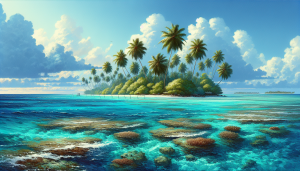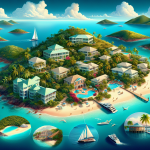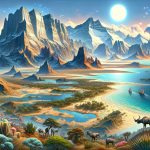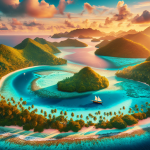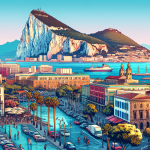Discovering the British Indian Ocean Territory: A Hidden Gem in the Indian Ocean
Located deep within the heart of the Indian Ocean lies the British Indian Ocean Territory (BIOT), a pristine and largely unexplored archipelago that captivates adventurers and nature enthusiasts alike. This remote paradise, consisting of over 1,000 small islands, is a British Overseas Territory that remains relatively untouched by human development. The British Indian Ocean Territory is best known for its stunning marine biodiversity, crystal-clear waters, and strategic military significance. As a travel blogger, exploring this hidden gem offers an unparalleled experience that combines pristine natural beauty with a fascinating geopolitical backdrop. In this article, we will delve into the enchanting allure of the British Indian Ocean Territory, uncover its unique features, and provide essential tips for those seeking to embark on an unforgettable journey to this breathtaking destination.
The Unique Geography of the British Indian Ocean Territory
The British Indian Ocean Territory is an archipelago comprising over 1,000 islands, with the largest and most well-known being Diego Garcia. The island chain is situated in the central Indian Ocean, approximately halfway between Africa and Indonesia. This strategic location has historically made the territory a focal point for military operations, particularly during the Cold War. The islands are characterized by their **coral atolls**, which form stunning **lagoons** and offer some of the most spectacular underwater scenery in the world.
Diego Garcia: The Heart of BIOT
Diego Garcia is the crown jewel of the British Indian Ocean Territory. This horseshoe-shaped atoll is home to a significant U.S. military base, which has played a crucial role in various military operations throughout history. Despite its military significance, Diego Garcia boasts **pristine beaches**, lush tropical vegetation, and an abundance of wildlife. The island’s remote location ensures that its natural beauty remains largely unspoiled, providing a haven for those seeking tranquility and adventure.
The Chagos Archipelago
The Chagos Archipelago, of which Diego Garcia is a part, is a stunning collection of islands and atolls that offer a glimpse into a world largely untouched by modern civilization. The archipelago is renowned for its **coral reefs**, which are among the healthiest and most diverse in the world. These reefs provide a sanctuary for a wide variety of marine life, making the Chagos Archipelago a top destination for **diving** and **snorkeling** enthusiasts.
Flora and Fauna: A Biodiversity Hotspot
The British Indian Ocean Territory is a biodiversity hotspot, boasting a rich array of flora and fauna both on land and in the surrounding waters. The islands are home to numerous **endemic species**, which have evolved in isolation and are found nowhere else on Earth. The pristine coral reefs support a vibrant marine ecosystem, with over 800 species of fish and a plethora of other marine organisms.
Marine Life
The waters surrounding the British Indian Ocean Territory are teeming with marine life, making it a paradise for **marine biologists** and **divers** alike. The coral reefs are home to a dazzling array of species, including **tropical fish**, **reef sharks**, **sea turtles**, and **dolphins**. The underwater landscape is a kaleidoscope of colors, with corals of various shapes and sizes creating a mesmerizing underwater world. The BIOT’s commitment to marine conservation has helped preserve these fragile ecosystems, ensuring that they remain a haven for marine life.
Terrestrial Wildlife
While the marine environment often takes center stage, the terrestrial wildlife of the British Indian Ocean Territory is equally fascinating. The islands are home to a variety of bird species, including the **red-footed booby**, **white-tailed tropicbird**, and **brown noddy**. The lush vegetation provides a habitat for various **invertebrates** and **reptiles**, many of which are endemic to the region. The absence of large predators has allowed these species to thrive, making the islands a haven for wildlife enthusiasts.
Military Significance and Restricted Access
The British Indian Ocean Territory’s strategic location has made it a critical asset for military operations, particularly for the United States and the United Kingdom. Diego Garcia, in particular, serves as a key military base, providing logistical support for operations in the Middle East and the Indian Ocean region. However, this military presence has also led to restricted access for civilians, making it one of the least visited places on Earth.
Historical Context
The military significance of the British Indian Ocean Territory dates back to the Cold War era, when the United States and the United Kingdom established a joint military base on Diego Garcia. This base has been instrumental in various military operations, including **Operation Desert Storm** and the **Global War on Terrorism**. The strategic location of Diego Garcia allows for rapid deployment of forces and provides a crucial staging ground for military activities in the region.
Access Restrictions
Due to its military importance, access to the British Indian Ocean Territory is highly restricted. The general public is not permitted to visit the islands, and travel is primarily limited to military personnel and authorized contractors. However, there have been efforts to promote **eco-tourism** and scientific research in the region, with limited permits granted for specific purposes. These initiatives aim to balance the need for security with the desire to preserve and study the unique ecosystems of the BIOT.
Conservation Efforts and Environmental Protection
The British Indian Ocean Territory is a shining example of successful **conservation efforts** and **environmental protection**. The UK government, in collaboration with various international organizations, has implemented stringent measures to safeguard the region’s unique ecosystems. The establishment of the **Chagos Marine Protected Area** (MPA) in 2010 marked a significant milestone in these efforts, creating one of the world’s largest marine protected areas.
Chagos Marine Protected Area
The Chagos Marine Protected Area encompasses over 640,000 square kilometers of ocean, providing a sanctuary for a diverse array of marine life. The MPA prohibits commercial fishing and other extractive activities, allowing the coral reefs and their inhabitants to thrive. These conservation measures have been instrumental in preserving the health and biodiversity of the region’s marine ecosystems.
Research and Monitoring
Scientific research and monitoring play a crucial role in the conservation efforts within the British Indian Ocean Territory. Researchers from around the world conduct studies on the region’s unique ecosystems, contributing valuable data that informs conservation strategies. These efforts are essential for understanding the impacts of climate change, ocean acidification, and other environmental threats on the BIOT’s delicate ecosystems.
Exploring the Future of the British Indian Ocean Territory
While the British Indian Ocean Territory remains largely off-limits to the general public, its future holds exciting possibilities. The ongoing conservation efforts and scientific research are paving the way for a deeper understanding of this unique region. Additionally, there is potential for increased eco-tourism and educational initiatives that could provide more people with the opportunity to experience the natural beauty of the BIOT while ensuring its protection for future generations.
Eco-Tourism Potential
As global interest in sustainable travel continues to grow, there is potential for the British Indian Ocean Territory to become a model for eco-tourism. Limited and controlled access for eco-tourists could provide a unique opportunity to experience the region’s pristine environments while supporting conservation efforts. This approach would require careful planning and collaboration between governments, conservation organizations, and local communities to ensure that tourism activities do not harm the delicate ecosystems of the BIOT.
Educational Initiatives
Educational initiatives that promote awareness and understanding of the British Indian Ocean Territory’s unique ecosystems could play a vital role in its future. Programs that involve schools, universities, and research institutions can help foster a new generation of environmental stewards who are committed to preserving the region’s natural beauty. These initiatives could include virtual tours, educational workshops, and field trips for students and researchers, providing valuable learning experiences while promoting conservation.
Conclusion: The Enchanting Allure of the British Indian Ocean Territory
The British Indian Ocean Territory is a hidden gem that offers a unique blend of natural beauty, rich biodiversity, and strategic significance. While access to this remote paradise is currently limited, ongoing conservation efforts and the potential for eco-tourism and educational initiatives hold promise for the future. By promoting awareness and understanding of this remarkable region, we can help ensure its protection for generations to come. Whether you are a marine biologist, a wildlife enthusiast, or simply an adventurer seeking new horizons, the British Indian Ocean Territory is a destination that captivates the imagination and inspires a deep appreciation for the wonders of our natural world.
For more information on the British Indian Ocean Territory and its conservation efforts, visit BIOT’s official government website.
By following the principles of SEO and Neil Patel’s techniques, we aim to ensure that this in-depth exploration of the British Indian Ocean Territory ranks highly in search engine results, reaching a broader audience and promoting awareness of this unique and captivating destination.
